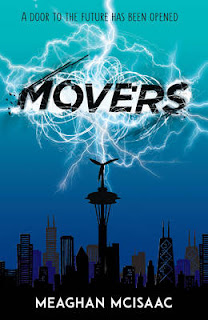
As a reader, I don't limit myself to one genre. But if I did, it would probably be SciFi. Why? I think it boils down to possibilities. Every great SciFi story, no matter how outlandish, how wild, how improbable, is made extra exciting by the idea that it could, maybe, just maybe, happen. Luke Skywalker could have become a Jedi a long time ago in a galaxy far, far away. Elliot could have found an alien in his backyard who needed to phone home. Maybe we could bring dinos back to life using fossilized tree sap. The universe is infinite! What's inspiring about stories under the SciFi umbrella is they make you feel like anything — for better or worse — is possible. And when anything is possible, the adventures have no limits.
So, in order to celebrate all things SciFi, I thought I'd share my top five favourite SciFi YA.
So, in order to celebrate all things SciFi, I thought I'd share my top five favourite SciFi YA.
1. The Chaos Walking trilogy by Patrick Ness
2. The Chrysalids by John Wyndham
This is the book, guys. My childhood fave that started my love of all things SciFi. In a post apocalyptic world, mutations are considered blasphemies against God and must be destroyed. So when David discovers that he and a small group of other teens have telepathic abilities, they are forced to keep it secret. But like any good secret, it can't stay that way, and it's not long before David and his friends are on the run. This is one I'm desperate to see on the big screen — but I don't know how any movie could pull off the awesome "thought shape" parts and do it proper justice. If you haven't read it, go now, and together we can all come up with the best way to translate The Chrysalids to film, I just know it.
3. Glow by Amy Kathleen Ryan
I love, love, LOVE Glow. Mostly because if there were a mission to populate another planet in another galaxy, I like to think I'd have the guts to go. But anyway, fifteen-year-old Waverly was born aboard the Empyrean, a ship with just such a mission. It's one of two ships sent to populate a distant planet. And teenage life aboard the Empyrean is just about as normal as life back home — chores, parents, boyfriends. But then their sister ship, the New Horizon sends out a distress call. Something is wrong. And its up to the Empyrean to save them. But Waverly and her shipmates don't know, is that the crew aboard the New Horizon is anything but friendly. The setting of Glow—trapped on a ship in deep space—and the threat that lurks inside, makes for one claustrophobic read. I read it in one sitting.
4. The Fifth Wave by Rick Yancey
Two words: alien invasion. I shouldn't have to explain. But I will. Cassie Sullivan has survived the first four waves of attacks from the aliens that have invaded earth. Everyone else on the planet hasn't been so lucky. And the few survivors that are left can't be trusted. Anybody could be one of them in disguise. And somewhere out there is Cassie's little brother Sam. And it's up to her to get him back. This action-
5. Red Rising by Pierce Brown
If SciFi is all about possibility, then let's do all we can to avoid the possibility of a future like the one sixteen-year-old Darrow was born to. Society is divided by a colour-coded caste system, with Golds at the top, and Reds, like Darrow, at the bottom. When a family tragedy forces Darrow to reject the system, he'll have to become the very thing he hates in order to bring it down. Brutal, dark and dangerous, Darrow's world is both exciting and terrifying. And it's just the first in the series.
 So there you have just a few of my favourite SciFi YA offerings. It's time to get reading! And even if you think SciFi isn't for you, I have to insist that you're wrong — the endless possibilities means there's something in this genre for everyone. You can't not find a great story here. It's impossible! (See what I did there?) What are some of your favourite SciFi reads?
So there you have just a few of my favourite SciFi YA offerings. It's time to get reading! And even if you think SciFi isn't for you, I have to insist that you're wrong — the endless possibilities means there's something in this genre for everyone. You can't not find a great story here. It's impossible! (See what I did there?) What are some of your favourite SciFi reads?Tweet Meaghan your favourite SciFI reads
Find out more about Movers
Find out more about Shadows
About Meaghan:
Meaghan writes middle grade and young adult books. She loves to read them too. She used to draw a bit. When she was nine, she drew comics about a bird family who had a fuzzy orange caterpillar for a dog. They never ate him. After that, she gave a lot of embarrassing performances in her high school's musicals. She gave up on acting and decided to stick to telling stories. Meaghan packed up and left for the UK where she completed an MA in Children's Writing at the University of Winchester. Now, she's back in Toronto, reading and writing. Meaghan has one noisy beagle and one lab who doesn't stop eating. Meaghan is the author of an exhilarating, action-packed SciFi series. Movers is the first book in the series and Shadows, the second. Both are available online and from all good bookstores.











